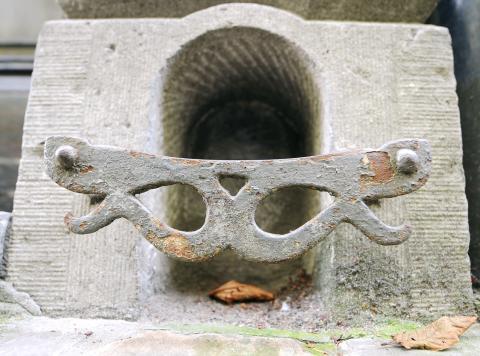Prized by antique dealers, revered by history buffs, but an object of puzzlement to many a 21st-century pedestrian, the humble boot scraper is back in the spotlight in its favored home, Belgium.
Known as a decrottoir in French, which, taken literally, implies the need to remove excrement, the cast-iron contraptions feature in London, New York and other major world cities, but abound in Belgium’s 18th and 19th century streets.
Nowhere is the implement crafted to scrape mud off shoes more visible than in this country, according to academics from the Free University of Brussels, or Universite Libre de Belgique (ULB).

Photo: AFP
“Boot scrapers were born at the same time as footpaths. This mundane contraption from daily life is a key to urban history,” ULB history professor Christian Loir said. “It is part of the history of walking in our cities.”
Set in semi-circular niches beside the front doors of most homes, the ground-level scrapers have long fascinated the tens of thousands of expatriates sent to Brussels each year to work at the many EU-linked institutions and diplomatic missions.
“I like to tell children they are the front doors of the house gnomes,” a blogger said.
“I’ve become a little obsessed with these contraptions, pointing out the prettiest whenever I’m strolling along the cobblestone footpaths of Brussels,” another wrote.
Brussels’ biggest university recently focused on the early version of today’s doormat at a world forum on the history of walking and urban space, and a central city exhibition is highlighting the almost 1,000 different models found on city streets today.
TESTIMONIALS
Professor Laurence Rosier, who teaches at the ULB and curated the show, said the scrapers were a testimonial to the stonemasons and ironworkers of yesteryear, as well as to the invention of the contemporary footpath.
Though the ancient Romans built footpaths, only the poor walked Europe’s cities until the late 18th century, when the upper classes of the time hopped off their carriages to amble the streets.
“Walking suddenly became fashionable,” Loir said. “This was a key moment in urban history, when the elite discovered the city. The impact was enormous.”
The sudden popularity of walking the streets helped shape today’s cities, with footpaths, tree-lined boulevards, public parks and covered arcades built during the 19th century.
“Suddenly there was a new quality to public space,” Loir said.
CHANGING TIMES
The new taste for strolling also saw shoes morph from heavy high-heeled designs for indoors to softer, low-heeled, foot-fitting gear, as scientists engrossed themselves in the study of motor skills and local authorities turned to public hygiene, improving sewerage and offering public toilets.
In the first decades of the 19th century, footpaths were lined with scrapers to wipe off the mud and excrement before going indoors. As more and more people adopted the walking habit, it became vital to clear a special space for the new pedestrian class, safe from the flying mud and bolting horses. In the 1840s, scrapers were ordered off the street as authorities in Belgium removed all obstructions in the interests of public safety.
Instead, the ubiquitous decrottoir was now fixed to houses, by the front door, leading to a change in social habits such as removing one’s shoes on going inside.
“There were manuals published on how to enter a home, how to be civil by not taking off one’s shoes, and huge catalogs on manufacturers” of boot scrapers, said Rosier, who with photographer Christophe Holemans spent several years researching the subject before the summer show.

The Burmese junta has said that detained former leader Aung San Suu Kyi is “in good health,” a day after her son said he has received little information about the 80-year-old’s condition and fears she could die without him knowing. In an interview in Tokyo earlier this week, Kim Aris said he had not heard from his mother in years and believes she is being held incommunicado in the capital, Naypyidaw. Aung San Suu Kyi, a Nobel Peace Prize laureate, was detained after a 2021 military coup that ousted her elected civilian government and sparked a civil war. She is serving a

China yesterday held a low-key memorial ceremony for the 1937 Nanjing Massacre, with Chinese President Xi Jinping (習近平) not attending, despite a diplomatic crisis between Beijing and Tokyo over Taiwan. Beijing has raged at Tokyo since Japanese Prime Minister Sanae Takaichi last month said that a hypothetical Chinese attack on Taiwan could trigger a military response from Japan. China and Japan have long sparred over their painful history. China consistently reminds its people of the 1937 Nanjing Massacre, in which it says Japanese troops killed 300,000 people in what was then its capital. A post-World War II Allied tribunal put the death toll

‘NO AMNESTY’: Tens of thousands of people joined the rally against a bill that would slash the former president’s prison term; President Lula has said he would veto the bill Tens of thousands of Brazilians on Sunday demonstrated against a bill that advanced in Congress this week that would reduce the time former president Jair Bolsonaro spends behind bars following his sentence of more than 27 years for attempting a coup. Protests took place in the capital, Brasilia, and in other major cities across the nation, including Sao Paulo, Florianopolis, Salvador and Recife. On Copacabana’s boardwalk in Rio de Janeiro, crowds composed of left-wing voters chanted “No amnesty” and “Out with Hugo Motta,” a reference to the speaker of the lower house, which approved the bill on Wednesday last week. It is

FALLEN: The nine soldiers who were killed while carrying out combat and engineering tasks in Russia were given the title of Hero of the Democratic People’s Republic of Korea North Korean leader Kim Jong-un attended a welcoming ceremony for an army engineering unit that had returned home after carrying out duties in Russia, North Korean state media KCNA reported on Saturday. In a speech carried by KCNA, Kim praised officers and soldiers of the 528th Regiment of Engineers of the Korean People’s Army (KPA) for “heroic” conduct and “mass heroism” in fulfilling orders issued by the ruling Workers’ Party of Korea during a 120-day overseas deployment. Video footage released by North Korea showed uniformed soldiers disembarking from an aircraft, Kim hugging a soldier seated in a wheelchair, and soldiers and officials